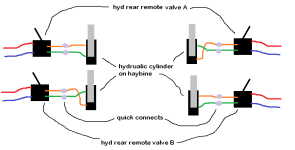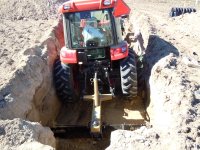cat fever
Elite Member
My question is this; The Stock hydraulic set up on my tractor lifts and lowers my haybine just fine slow or fast just move the lever and it works.
The 2nd hydraulic I had added at the dealer lifts just fine but there is no control of the lowering of the haybine. It just drops like a ton of bricks.
Should both sets work the same? My thoughts are yes.
To be clear this is what I've done. On the stock set up I always use the left side of the pair. My haybine is a single line hydraulic cylinder.
On the added one I used the right side of the pair. So does it matter?
The other day I was working on the haybine and needed to watch something while it was slowly being lowered. At first I was going to be under it while my wife lowered it. I tested it first to see how fast or slow it was going to drop. Good thing I did, otherwise it would have crushed me. Some good lessons learned without dying.
So is there a problem with the second hydraulic set up? Or does it matter which side of the pair I use?
The 2nd hydraulic I had added at the dealer lifts just fine but there is no control of the lowering of the haybine. It just drops like a ton of bricks.
Should both sets work the same? My thoughts are yes.
To be clear this is what I've done. On the stock set up I always use the left side of the pair. My haybine is a single line hydraulic cylinder.
On the added one I used the right side of the pair. So does it matter?
The other day I was working on the haybine and needed to watch something while it was slowly being lowered. At first I was going to be under it while my wife lowered it. I tested it first to see how fast or slow it was going to drop. Good thing I did, otherwise it would have crushed me. Some good lessons learned without dying.
So is there a problem with the second hydraulic set up? Or does it matter which side of the pair I use?


